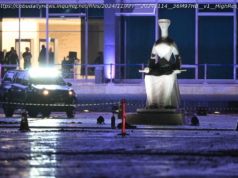The deadly tsunami that struck Indonesia this weekend is just the latest in a series of seismic disasters along the "Ring of Fire"
Updated on: December 24,2018 / 12:09 PM
/ CBS/AP
The deadly tsunami that struck Indonesia this weekend is just the latest in a series of seismic disasters along the “Ring of Fire,” the arc of fault lines encircling the Pacific Ocean. The Ring of Fire — stretching from New Zealand to Indonesia to Japan on the Asian side, and from southern Alaska down through the Pacific Northwest, California, Mexico and the western coast of South America — is where the continental plates meet, and where most of the world’s earthquakes and volcanic activity occur.
“We’re almost always seeing activity there,” Time magazine’s Bryan Walsh told “CBS This Morning” after a series of quakes earlier this year. “More than 80 percent of earthquakes that happen globally happen along this ring.”
The ring also encompasses about 450 volcanoes, including all of the most active volcanoes in the U. S.
The eruption of a volcano called Arak Krakatau, or “Child of Krakatoa,” off the coast of Indonesia, is believed to have set off the chain of events that led to the deadly tsunami Saturday night. Scientists believe a steep slope of the erupting volcano collapsed — either above ground or underwater — pushing waves out to sea that slammed into the Java coastline a short time later.
“The first satellite imagery returned after the event on Saturday points strongly to a collapse in the west-southwest flank of the volcano,” reports BBC News science correspondent Jonathan Amos. “This would have sent millions of tonnes of rocky debris into the sea, pushing out waves in all directions.”
It did not trigger a tsunami alert, and the deadly wave struck without warning. More than 300 people were killed, including members of a popular band and fans watching them perform at a beachside resort.
The 1,000-foot -high Anak Krakatau lies on an island in the Sunda Strait between Java and Sumatra islands, linking the Indian Ocean and the Java Sea. It has been erupting since June and did so again about 24 minutes before the tsunami, Indonesia’s Meteorology and Geophysics agency said.
“Actually, the tsunami was not really big, only 1 meter (3.3 feet),” said Gegar Prasetya, co-founder of the Tsunami Research Center Indonesia, who has studied Krakatoa. “The problem is people always tend to build everything close to the shoreline.” Scientists said the high tide, coinciding with a full moon, may have contributed as well.
The volcano where the eruption occurred has a particularly lethal history. It formed in the sea in the decades after the 1883 eruption of the Krakatoa volcano, one of the largest, most devastating in recorded history. That disaster killed more than 30,000 people, launched far-reaching tsunamis, and spewed so much ash into the atmosphere that day was turned to night in the area and temperatures dropped worldwide.
Most of the island sank into a volcanic crater under the sea, and the area remained calm until the 1920s, when Anak Krakatau began to rise from the site. It continues to grow each year and erupts periodically.






